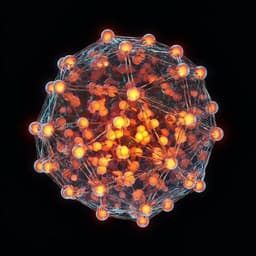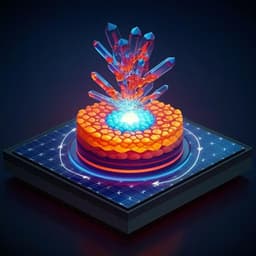
Engineering and Technology
Surface chemical polishing and passivation minimize non-radiative recombination for all-perovskite tandem solar cells
Y. Pan, J. Wang, et al.
Discover the groundbreaking research by Yongyan Pan and colleagues on all-perovskite tandem solar cells, which showcases a surface reconstruction strategy that dramatically improves efficiency by eliminating defects. This innovative approach has led to Sn-Pb mixed perovskite films achieving power conversion efficiencies of up to 28.49%! Tune in to learn more!
~3 min • Beginner • English
Introduction
Perovskite solar cells have rapidly advanced, with single-junction devices reaching 26.7% PCE. Monolithic all-perovskite tandems that stack wide-bandgap (~1.7–1.9 eV) and narrow-bandgap (~1.2–1.3 eV) subcells surpass the Shockley–Queisser limit, and certified tandem efficiencies have reached 30.1%. Nevertheless, tandem performance is limited by large open-circuit voltage deficits and relatively low fill factors, primarily due to severe non-radiative recombination at the interface between Sn–Pb mixed narrow-bandgap perovskites and C60-based electron transport layers. This interfacial recombination arises from surface defects produced during the rapid and uncontrollable crystallization of Sn–Pb perovskites: surface Sn2+ enrichment, its oxidation to self-doping Sn4+, and loss of organic species during annealing that creates organic cation and iodide vacancies (VA, VI). Addressing these surface defects and their energetic misalignment at the perovskite/ETL interface is essential to reduce non-radiative losses and improve VOC and FF in all-perovskite tandems. The study aims to develop an effective surface reconstruction that simultaneously removes Sn-related defects and passivates vacancy defects to minimize interfacial recombination and optimize energy level alignment.
Literature Review
Prior work has demonstrated the potential of all-perovskite tandems and highlighted interfacial recombination as a key bottleneck. Sn–Pb perovskites suffer from surface Sn2+ accumulation and oxidation to Sn4+ (self-doping), as well as VA and VI formation from volatilization of organic species during annealing. Numerous interface engineering strategies have been explored (e.g., surface passivators and molecular modifiers), but single passivators often show limited ability to simultaneously eliminate Sn4+ and passivate both donor- and acceptor-like defects, and may not correct energy level misalignment with C60. Recent advances improved grain surface passivation and heterojunction quality, yet VOC deficits and FF losses remain. These insights motivate a dual-function strategy that combines chemical polishing to remove defective surface layers and targeted passivation to neutralize residual defects while tuning surface energetics.
Methodology
The authors propose a two-step surface reconstruction for Sn–Pb mixed perovskite films: (1) chemical polishing using 1,4-butanediamine (BDA) to dissolve and remove Sn-rich, I-deficient defective surface layers and reduce Sn4+ formation; (2) synergistic passivation using ethylenediammonium diiodide (EDAI2) to passivate organic cation (VA) and halide (VI) vacancies and modulate surface dipoles for improved energy alignment with C60. Key methodological details include: - Materials and films: Ideal-bandgap FA0.7MA0.3Pb0.7Sn0.3I3 (1.32 eV) and Cs0.1FA0.6MA0.3Sn0.5Pb0.5I3 (1.25 eV) were prepared via DMF/DMSO solvent systems with additives (e.g., SnF2, MACl, GlyHCl, GuaSCN). Films were spin-coated using anti-solvent CB and annealed at 100 °C. - Surface treatments: BDA in IPA (optimized at 0.1 mg mL−1) was spin-coated (4000 rpm, 20 s) and annealed. For synergistic modification, EDAI2 was dissolved in BDA/IPA and applied similarly (BDA-EDAI2). Concentration studies revealed that low BDA forms an adsorbed layer enabling passivation without detectable low-dimensional phases, whereas higher BDA (≥0.5 mg mL−1) can form low-dimensional perovskite particles, especially at grain boundaries. - Device architectures: Single-junction inverted PSCs: ITO/PEDOT:PSS/Al2O3/perovskite/(BDA or EDAI2 or BDA-EDAI2)/C60/BCP/Ag (NBG); WBG PSCs used Me-4PACz as HTL. Monolithic tandems: Glass/ITO/Me-4PACz/Al2O3/WBG perovskite/PDAI2/C60/ALD-SnO2 (30 nm)/Au (1 nm)/PEDOT:PSS/Al2O3/NBG perovskite/BDA-EDAI2/C60/BCP/Ag. Modules: 5×5 cm2 substrates laser-scribed into 5 subcells (P1–P3), with ALD-SnO2 barrier and Cu rear electrode. - Characterization: XPS (surface stoichiometry and Sn oxidation states), KPFM (surface potential and ΔCPD at GBs vs interiors), GIWAXS/GIXRD/XRD (phase and strain), FTIR and 1H NMR (BDA–perovskite interactions; BDA–EDAI2 solubility effects), PL/TRPL and PLQY (non-radiative recombination), UPS (Fermi level and band alignment), EIS, TAS, Mott–Schottky (Vbi), TPV/TPC (recombination and transport), EL-EQE (non-radiative VOC loss), SEM/AFM (morphology). - Computational: DFT (VASP, PBE-GGA, PAW, 450 eV cutoff) assessed binding of diamines to defect sites and impact on Sn2+ oxidation barrier; molecules modeled in a 3×3×2 FASnI3 supercell with 20 Å vacuum. - Performance testing: J–V under AM1.5G (masked 0.0871 cm2); tandem EQE with bias illumination; MPPT stability in ambient air (30–40% RH).
Key Findings
- Surface reconstruction and stoichiometry: XPS showed BDA polishing brought the surface I/(Pb+Sn) ratio closer to bulk and reduced surface Sn content from 27.3% to 19.1%, exposing well-crystallized perovskite and reducing Sn4+. - Surface potential homogenization: KPFM indicated a more uniform surface potential; mean ΔCPD (GBs–GI) decreased from 45 mV to 29 mV after BDA polishing, consistent with fewer surface/GB defects and improved charge transfer. - Structural integrity: GIWAXS showed no detectable low-dimensional perovskite at 0.1 mg mL−1 BDA; higher BDA created secondary particles attributed to BDA-derived low-dimensional phases. Residual tensile strain near the surface decreased from 53.76 MPa (control) to 31.21 MPa after BDA-EDAI2. - Defect passivation and recombination suppression: PL and TRPL showed enhanced emission and longer lifetimes with BDA-EDAI2 (τavg ≈ 1.55 μs) vs EDAI2 (1.22 μs) and BDA (1.11 μs). Film PLQY increased from 0.43% (control) to 1.15% (BDA-EDAI2). Perovskite/C60 stack PLQY improved from 0.030% (control) to 0.22% (BDA), 0.26% (EDAI2), and 0.58% (BDA-EDAI2). - Energy-level alignment: UPS revealed the control surface was p-type due to Sn4+ self-doping; BDA or EDAI2 upshifted the Fermi level, and BDA-EDAI2 achieved the largest upshift to −4.72 eV, minimizing band offset with C60 and facilitating electron extraction. Mott–Schottky Vbi increased from 0.67 to 0.75 eV. - Voltage loss analysis: Non-radiative VOC loss reduced by 83 mV (from EL-EQE). QFLS analysis showed reduced losses within the perovskite and at the perovskite/C60 interface. - Device performance (single junctions): For 1.32 eV NBG PSCs, champion PCE 22.65% with VOC 0.898 V, JSC 30.96 mA cm−2, FF 81.47%; integrated JSC 30.12 mA cm−2 (EQE). Average PCE improved from 17.63% (control) to 22.27% (BDA-EDAI2). For 1.25 eV NBG PSCs, PCE reached 23.32% with VOC 0.878 V and FF 81.55%. - Device performance (tandems): Monolithic all-perovskite tandem (active area 0.0871 cm2) achieved PCE 28.80% (reverse, 28.76% forward), VOC 2.13 V, JSC 16.06 (16.04) mA cm−2, FF 84.19% (84.17%). Certified PCE: 28.49% with VOC 2.12 V and FF 83.88%. Subcell EQE integrated JSC: WBG 15.70 mA cm−2, NBG 15.32 mA cm−2 (well matched). - Modules and stability: Tandem module (11.3 cm2 aperture, 5 subcells) reached PCE 23.39% (reverse; 23.27% forward), VOC 10.2 V, JSC 2.937 mA cm−2, FF 78.08%. Encapsulated tandem cells retained 79.7% of initial PCE after 550 h MPPT in ambient air; ideal-bandgap PSCs retained 87.6% after 500 h MPPT.
Discussion
The combined chemical polishing and passivation approach directly targets the root causes of interfacial non-radiative recombination in Sn–Pb perovskites. BDA chemically interacts with perovskite constituents (Lewis base coordination to Pb2+/Sn2+ and hydrogen bonding with FA+), dissolving defective Sn-rich/I-deficient surface layers, decreasing Sn4+ self-doping, and homogenizing surface potentials at grains and GBs. EDAI2 passivates VA and VI defects and introduces favorable surface dipoles, while BDA also enhances EDAI2 solubility and delivery. The synergistic BDA-EDAI2 modification thus suppresses both donor- and acceptor-like traps and optimizes band alignment with C60, leading to higher Vbi, reduced ideality factor, suppressed interfacial recombination (higher PLQY at perovskite/C60), improved charge extraction (TPC/TPV), and significantly reduced non-radiative VOC losses. These interfacial improvements translate to higher VOC and FF in single-junction NBG cells and record-competitive PCEs in monolithic all-perovskite tandems with excellent current matching. The strategy is gentle (minimal changes to bulk crystallinity and absorption), scalable to modules, and generalizable to various Sn-based compositions (FASnI3 and FA0.6MA0.3Cs0.1Pb0.5Sn0.5I3), indicating broad relevance for advancing all-perovskite tandem photovoltaics.
Conclusion
This work introduces an effective surface reconstruction strategy for Sn–Pb mixed perovskites by combining BDA chemical polishing with EDAI2 passivation. The method yields near-stoichiometric, defect-deficient surfaces with uniform surface potential and improved energy-level alignment to C60, reducing interfacial non-radiative recombination and residual strain. Consequently, ideal-bandgap and 1.25 eV NBG PSCs achieved PCEs of 22.65% and 23.32%, respectively, while monolithic all-perovskite tandems delivered a certified 28.49% PCE (VOC 2.12 V, FF 83.88%). The approach also proved compatible with mini-modules and improved operational stability. Future work could explore: optimizing concentrations and processing windows to avoid low-dimensional phase formation; extending compatibility to alternative ETLs; long-term outdoor stability and accelerated aging; and scaling to larger modules with interconnect and optical loss minimization.
Limitations
- Concentration sensitivity: At higher BDA concentrations (e.g., 0.5 mg mL−1), secondary-phase particles and low-dimensional perovskite features appear, especially at grain boundaries, which could affect uniformity and performance. - Stability scope: Operational stability was demonstrated for 500–550 hours under MPPT in ambient air; longer-term, harsher environmental testing is needed to fully assess durability for practical deployment. - Device area: Record performances were demonstrated on small-area cells (0.0871 cm2) and mini-modules (11.3 cm2); further scaling and process control for larger-area modules remain to be validated. - Interface specificity: Improvements are demonstrated primarily for C60-based ETLs; generality to other ETLs and device stacks requires additional verification.
Related Publications
Explore these studies to deepen your understanding of the subject.







